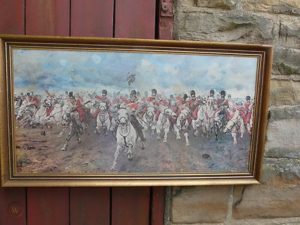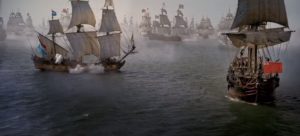About the lists: Calls to socially distance and self-isolate are driving people to look for things to watch. But the sheer amount of options out there can be overwhelming. For this reason, we at the Centre for Screen Cultures are producing themed playlists of film, video, and television so you can organise your own series or festival at home (or home school). They will update here and here: https://screenculture.wp.st-andrews.ac.uk/category/media-playlists/
In this list, writer and filmmaker Gillian McIver reflects on the painterliness of cinema– something that goes beyond simply ‘looking like’ a painting:
History painting as cinema
‘Painterly’ is a terms often encountered in discussion of films, but it’s a term that, while it seems immediately understandable, is quite hard to define. Sergei Eisenstein once said – provocatively of course – that ‘not even a film novice would now analyse film shot as if it were an easel painting’ But painterly does not mean that a film (a shot, a still or a sequence) simply ‘looks like’ a painting, rather that the film style recalls painting – maybe in the composition, colour and tonality, lighting, mise en scène or gesture. And just as often, painterliness is embedded in the storytelling.
I’ve avoided films ‘about’ art here, and my list is deeply subjective, of course!
History painting was the greatest of the genres, and most painters before the mid-19th century aspired to be history painters. Both the canvas and the subject matter was supposed to be monumental: scenes from mythology or the Bible, or real-life historical events like John Singleton Copley’s Siege of Gibraltar, September 1782 (the biggest painting in the UK, at Guildhall Art Gallery) or Géricault’s infamous Raft of the Medusa.
In this list, I’ll provide a film and painting pairings that engage our thinking on the subject.
Waterloo (Sergei Bondarchuk, 1970)- a period epic about the Battle of Waterloo.

One of my favourite film-painting linkups is Sergei Bondarchuk’s Waterloo (1970), which harnessed the might of the Red Army for the splendid battle scenes. The infamous charge of the Scots Greys replicates the massive painting by Elizabeth Southerden, Lady Butler (Britain’s finest 19thC war painter) which hangs in Leeds Art Gallery. The film is available to rent on Amazon, Google Play, and YouTube.
Painting: Elizabeth Southerden, Lady Butler , Scotland Forever!
https://artuk.org/discover/artworks/scotland-for-ever-38645

Michiel de Ruyter/Admiral (Roel Reiné, 2015)- a military biopic about the Dutch Fleet trade war triumphs.

Dutch-American director-cinematographer Roel Reiné uses Golden Age Dutch paintings intensively in the mise en scéne of his 2015 film Admiral (Dutch title: Michiel de Ruyter), particularly mapping his bravura sea-battle scenes onto paintings (many done in situ) by artists like van de Velde, Beerstratten, Backhuysen and others. Admiral is available to rent on Amazon and YouTube.
Painting: Peter van de Velde, Het verbranden van de Engelse vloot voor Chatham, 20 juni 1667/ The burning of the English fleet off Chatham, 20 June 1667. Rijksmuseum SK-A-307

https://www.rijksmuseum.nl/nl/collectie/SK-A-307
Painterly Filmmaker Uli Edel: Last Exit to Brooklyn (1989) and The Baader-Meinhof Complex (2008)

Films can be painterly without directly or obviously adapting paintings directly into the film. Many of Uli Edel’s films demonstrate a painterly eye, from the grimily realist Christiane F (1981) to Last Exit to Brooklyn (1990), highly flavoured with the Neue Sachlichkeit (‘New Objectivity’) visions of Georg Grosz.
Last Exit to Brooklyn is available to rent on Amazon.
Painting: George Grosz Suicide (Tate Modern)

https://www.tate.org.uk/art/artworks/grosz-suicide-t02053
https://youtu.be/2RZlaf_OMXs

In 2008 he turned to recent Germany history in The Baader-Meinhof Complex, and his painterly instinct is present again, recreating real-life events as huge set-pieces reminiscent of Rubens or Delacroix.
The Baader-Meinhof Complex is available to rent on Amazon.
Painting: Rubens Massacre of the Innocents (AGO)

http://www.ago.net/agoid106855
English-language trailer (not as good)
Gillian McIver is the author of Art History for Filmmakers (Bloomsbury, 2016). She recently completed a PhD on the relationship between painting and historical films.
